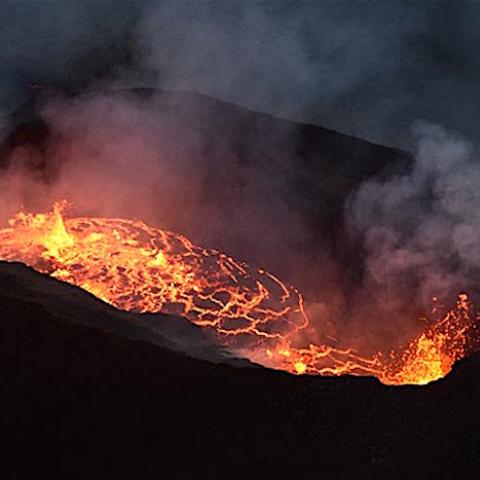
This photo of the glow from Kīlauea's latest eruption was captured about 3 a.m. local time Monday by Yvonne Baur from the Hawaiʻi Pacific Parks Association.
A growing series of earthquakes culiminated Monday in an eruption of the Kīlauea volcano at Hawai'i Volcanoes National Park in a remote area of the park where there hasn't been an eruption since 1974.
The U.S. Geological Survey reported that the eruption, which began about 12:30 a.m. local time Monday, was "likely about a mile (1-2 km) south of Kīlauea caldera and north of the Koa'e fault system and Hilina Pali Road, within Hawai'i Volcanoes National Park."
The eruption prompted the USGS's Hawaiian Volcano Observatory (HVO) to raise the Volcano Alert Level for ground-based hazards from WATCH to WARNING and the Aviation Color Code from ORANGE to RED.
"Glow is visible in webcam imagery, indicating that lava is currently erupting from fissures," the observatory reported. "The most recent eruption in this region was during December 1974, which lasted only about 6 hours. At this time, it is not possible to say how long the eruption will last."
The volcano most recently erupted last September.
The current eruption is in an area of the national park that is closed to the public. Still, due to the remote and unpredictable nature of the fissure eruption, the National Park Service issued the following temporary closures:
- Hilina Pali Road from Chain of Craters Road intersection
- Kulanaokuaiki Campground
- Pepeiao Cabin
- Kaʻaha Trail and campground
- Kaʻū Desert Trail and pullout on Highway 11
- Maunaiki Trail

While there are no spots where visitors can view the actual eruption, the Park Service says "a beautiful red-orange lava glow was visible in the sky before dawn from overlooks along Crater Rim Trail, including Uēkahuna and Volcano House. Early risers witnessed the glowing evidence of Pele, the elemental force of Hawaiian volcanoes, return for the first time since Septemeber 2023. After daybreak, a wispy distant gas plume became visible from Uēkahuna and other summit overlooks."
On Sunday the USGS had reported that the volcano exhibited increased seismic activity at approximately 12 p.m. HST, "indicating that magma was moving below the surface. Rates of seismicity and deformation increased further after 5 p.m., prompting the USGS Hawaiian Volcano Observatory to raise Kīlauea’s alert level/aviation color code from ADVISORY/YELLOW to WATCH/ORANGE."
However, by 10:30 p.m., the activity had decreased slightly. There had been approximately 250 earthquakes beneath Kīlauea’s summit region over the past eight hours, the observatory reported Sunday night.
"These earthquakes have been widely felt in Hawaiʻi Volcanoes National Park and surrounding communities, and have triggered many rockfalls. Earthquake activity has been accompanied by elevated rates and changing patterns of ground deformation," the agency said.




 Support Essential Coverage of Essential Places
Support Essential Coverage of Essential Places







Add comment